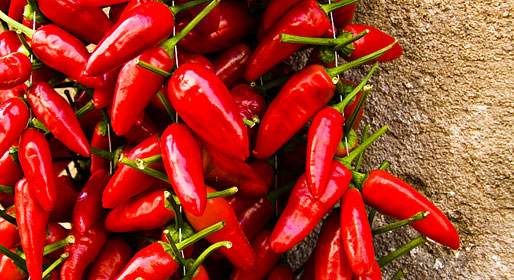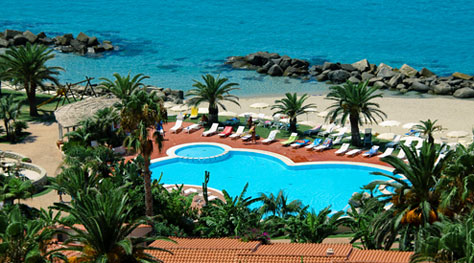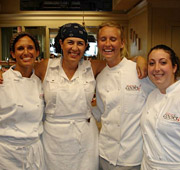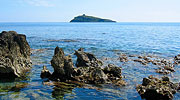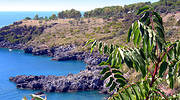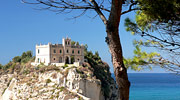Hot stuff
Origins and evolution of Calabria's peperoncino.
Diavolillo, pipazza, pipi vruscente, cancarillo: just some of the names Calabrians call one of the region's most-loved products: the peperoncino, or hot chili pepper.
On the porch of every house and hanging from the ceiling of every kitchen in Calabria, there can be found red garlands of peperoncino, a few jewels from which are often left on the dining table for those wishing to add even more heat to their meal.
Pirates and peperoncino
It is believed that peperoncino was introduced to Calabria by the Saracens and that the region quickly became the "hottest" in the whole peninsula.
The Murattiana Statistical report of 1811 mentions that Calabria's peperoncino was used for the preservation of meats and fish.
Today Calabria's peperoncino has been awarded DOP (Protected Designation of Origin) status and is one of the region's most important economic and cultural resources
What is certain about Calabrian peperoncino is that the exceptional level of heat of certain varieties is the direct result of the particular atmospheric and environmental characteristics of the territory in which it is cultivated, yet another reason why peperoncino has become an essential part of the Calabrian identity, influencing both the region's food and folklore.
Red hot chili peppers
One of the most important towns on this peperoncino-themed Calabrian itinerary is the coastal town of Diamante, in the province of Cosenza.
Diamante, or the "Tyrrhenian pearl", as Gabriele D'Annunzio called it, is one of the most popular tourist destinations on Calabria's west coast, famous for its enchanting historic center, crystal clear sea, long beaches and spectacular coastline.
Diamante is also known as the "town of murals" and, in fact, more than 150 colorful wall paintings by artists of international fame adorn the town's buildings.
The true symbol of Diamante is, nevertheless, the peperoncino, and a bright red statue of the capsicum has been erected at the entrance to the town.
In honor of this fiery fruit, the Peperoncino Festival is held every September. This celebration includes concerts, dances, film reviews, street theater and a competition to find the person capable of eating the greatest number of peppers.
The event, which has acquired international standing, is organized by the Italian Chili Pepper Academy.
Just a few kilometers North of Diamante is the Peperoncino Museum, in Maiera's Palazzo Dicale, an obligatory port of call for those keen to learn more about the origins and evolution of Calabria's favorite food
Calabrian caviar
Continuing on our expedition in search of Calabria's "red gold", we soon reach Cetraro, a fishing town famous for its beautiful historic center but also for its "rosmarina".
Known as "Mediterranean caviar" this delicacy is made with tiny little fish or "newborns", mixed with salt and peperoncino to produce a bright red paste, which is usually served on toasted bread.
The same recipe is used in other Calabrian seaside towns under the name of sardella salata, bianchetto or mustica, and is also used as a condiment for simple pasta dishes, perhaps enlivened with a little "Saint's oil": extra virgin olive oil flavored with peperoncino.
Gastronomic gifts
The area around Tropea and, in particular, the town of Spilinga, is famous for another gastronomic delicacy, a kind of soft salami made with bits of pig's head and impressive quantities of peperoncino. "Nduja" is used in many traditional recipes and often combined with Tropea's famous onions.
Rosamarina and 'nduja, together with a garland of scarlet peperoncino, are, without doubt, perfect edible souvenirs with which to remember a holiday in Calabria

